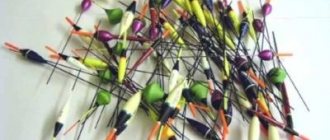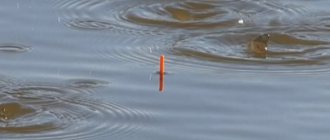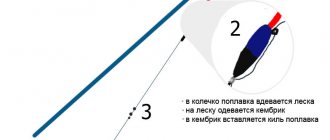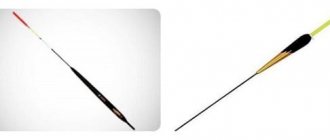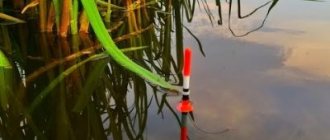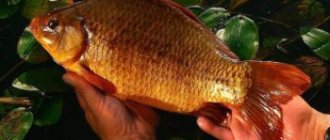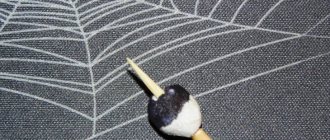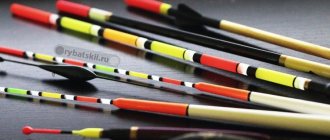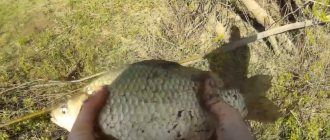Fishing for crucian carp is a real pleasure for every fishing enthusiast. It has long been noted that crucian carp is one of the most common fish in our state.
For this reason, every angler needs to know about the methods of catching it, as well as the equipment that is required for crucian carp. In particular, I would like to touch upon the issue of choosing floats, since this problem worries many crucian fishermen, I will try to cover it in the next text.
Which float is better for crucian carp?
A float has two main functions:
- Stay at the depth and prevent the hook and bait from sinking;
- Fish bite alarm.
A float is an ordinary body of rotation. The normal operating condition of the float is a vertical position relative to the surface of the water.
The components of the float have the following names and purposes:
- Keel - the lower, underwater part of the float. Its function is to hold and guide the baited hook along the bottom.
- Antenna is the upper part of the float, surface-mounted, the function of which is to ensure the stability of the float in the wind and to signal a bite.
- Waterline is a designation by which the float stays afloat in a strictly vertical sense.
For a float fishing rod, spherical floats are quite suitable, but do not forget to use oblong ones. The choice of float directly depends on the current in the reservoir.
The optimal float weight for a float fishing rod will be from 3 to 5 grams.
Any slightest touch of bait on a pond should be detected by the float, so the effectiveness of fishing as a whole largely depends on its sensitivity.
The float notifies the fish about the bite by chaotic deviations in different directions from its initial vertical position on the water.
Optimal float color
The color of the float is equally important for both the fish and the angler. The float, conditionally, can be divided into 2 parts: one part is under water, and the other is above water. The part that is under water should be quite noticeable, otherwise it will not be possible to notice the crucian bite in time.
- If fishing is carried out in cloudy weather, then it is better to use floats with a white or light green antenna.
- When fishing in clear sunny weather, black or red tips are suitable.
Tips for the fisherman: How to put a maggot on a hook for crucian carp - Let's take it step by step
The underwater part of the float should not contrast in the water column, so as not to alert the fish.
Floats for crucian carp made of plastic are cheaper and short-lived. Many brands practice a symbiosis of materials in the production of some models. Like other equipment elements, floats differ in parameters.
The advantage over feeder and bottom equipment is its wide range of applications. You can fish with a float rod in various conditions:
- rivers with slow and moderate currents;
- jet (for demolition or wiring);
- standing bodies of water: ponds and lakes;
- reservoir (from boat and shore);
- sea (from the pier or beach).
Float equipment is perfectly adapted to any body of water, so it can safely be called universal. You need to start searching for crucian carp at the edge of the reeds. A small portion of pre-prepared complementary food will attract and keep the fish on the spot. In artificial reservoirs, old maps will help you find prey. If you have a boat and knowledge about the flooded lake, the chances of success increase. Crucian carp is found more often in such places.
River fish are more active due to the current, but following the example of lake species, they prefer to stay in their homes. Fishing takes place while fishing. Floats for searching and catching crucian carp are used in the light class, because the bites are more delicate in the current.
4.3 out of 5
What should a float be like for crucian carp?
A float for catching crucian carp must meet the various conditions for catching this fish. Moreover, each float must be arranged for a specific place and time of fishing.
So, when fishing in windy weather, it is best to use a float weighing more than 5 grams. In calm water, the weight of the float should not exceed 3 grams.
If fishing is done with a Bolognese or plug fishing rod, the weight of the float should be significantly greater - approximately 10 grams. This is explained by the casting range of the gear.
With such weight categories, catching crucian carp will become more convenient in any weather conditions. It is also worth saying that the color scheme of the float will not affect the catch of crucian carp in any way. It is best if the top of the float is equipped with removable caps, which you will have included in the kit and in different colors.
Red and black caps also work well on the top of the float. The lower part of the float, immersed in water, must be dark in color.
An elongated float will allow you to accurately and quickly determine the bite of crucian carp. It is optimal if the tip is more than three centimeters in length. Moreover, the narrower it is, the better it will be.
The best result will be a tip with a diameter of two to three millimeters.
Fastening the float does not play a special role; everyone will agree that the catching ring should be located on top, and on the bottom of the float there should be a rubber nipple, which will allow you to carefully adjust the immersion depth of the equipment.
How to choose a waggler?
Waggler floats are manufactured in 2 types: body and rod. The first option is able to withstand the weight of several sinkers, helping to increase casting distance. The best at long-distance casting is the cigar-shaped waggler. It can be difficult for beginners to cope with the Wagner, since the heavy float, although it is thrown far, loses sensitivity. Practice will help. Try to fish more often in different bodies of water.
Tips for a fisherman: What kind of hook is needed to catch crucian carp - Answers for beginners
It is better to buy a branded Wagner, since it is difficult to achieve the desired range, coupled with sensitivity and workmanship, from a cheap one. Professionals also recommend paying attention to the following points:
Catching crucian carp with a float begins with the onset of spring warming, when the crucian carp comes out to actively feed and the water becomes much warmer. Crucian carp bite until mid-autumn, and sometimes all year round, but catching crucian carp with a float in the summer is considered the most productive.
Types of floats
It is also worth noting that today there are quite a lot of varieties of floats. Often the type of float on a fishing rod depends on the equipment.
For example, it could be a float for fishing rods with or without a reel, with or without rings on the fishing rod. Each type of float has its own characteristics, which are inherent in a certain type of fishing.
Float for fishing rod without reel
This type of float is very suitable for quiet and peaceful fishing. It is noteworthy that it is more convenient to use such equipment from the shore in calm water, preferably on a pond or lake. Typically, such floats have long shapes and are extended upward. Sometimes they can be equipped with a luminous tip for night fishing.
Float for fishing rods with long casting
For rods with a massive reel used for long casts, it is most convenient to use floats special for this purpose. Their weight varies from 5 to 8 grams; they must have an elongated barrel shape with a slight rounding at the top. It helps relieve eye strain while watching for a bite, and it’s also very convenient to monitor this type of float.
Rod equipment
There are many types of float rods. The fishing rod is selected based on the characteristics of the reservoir and the habits of the fish. Choosing the right gear for catching crucian carp with a float rod is the most important element of fishing. The future catch depends on what gear was chosen, as well as how it was installed on the fishing rod.
Fly rod
The main advantage of this fishing rod is its simplicity of equipment and ease of casting, as well as the fast pace of fishing. Due to the fact that the length of the fly rod is usually no more than six meters, it will not be possible to make a long cast. Therefore, they fish only in places of coastal vegetation, on rivers or from a boat.
The fly rod is equipped as follows:
Also, for comfortable fishing, the fishing line should be chosen so that its length exceeds the length of the rod by 50-60 cm.
Match fishing rod
It is not always necessary to catch crucian carp in coastal areas. Sometimes it is necessary to make long casts to great depths. It is in this situation that a match rod comes in handy, which allows the angler to cast over a distance of up to 30-40 meters. However, in order to be able to make such a cast, the rod must first be properly equipped. The equipment looks like this:
Please note that the floats used for fishing with a match rod are much less sensitive than those used for fishing with a fly rod. For this reason, the angler should monitor the float more closely.
Plug tackle
The newest of the float rods is the plug rod. Thanks to its enormous length, it allows the angler to very accurately deliver the bait at a distance of up to 15 m. Also, the advantages of this gear are silent casting and the ability to fish with delicate baits. The equipment of this fishing rod looks like this:
To ensure that the equipment of a float rod for crucian carp is correct, special attention should be paid to the junctions of various elements (line and leash, leash and hook, etc.). The most important tackle for crucian carp is a float rod. For this reason, you should be especially careful when choosing it.
During the hot season in mid-summer, the situation is different: crucian carp splashes all over the reservoir, but practically does not bite from the bottom, and, probably, few anglers tried to catch it from the top with a slight descent, but in vain. Only the tackle needed for such fishing is light (the float’s load capacity is 0.4-0.8 g), with a distributed load so that the bait sinks as naturally as possible in the water column, and the loud slaps in the water with heavy tackle do not frighten the fish. The descent is usually set from 0.5 to 1 meter.
Photos and drawings by the author
On summer crucian ponds, where in warm water the fish are satiated with natural food, we have often observed that even in these conditions, some fishermen successfully catch lazy and finicky crucian carp, while the majority are content with rare bites. Of course, this situation for losers can be created by errors in the selection of bait and bait, but most often this is determined by the incorrect construction of the float equipment specifically for crucian carp and the inability to control the tackle.
So, the most popular among fans of sports fishing for crucian carp since ancient times is the float rod. Almost the entire success of fishing depends on its correct equipment. What is the use of excellent complementary foods and a full range of baits if the fisherman does not notice the cautious summer bites of well-fed fish? The fish are alarmed by rough tackle that does not meet the fishing conditions (activity and size of the fish; presence of wind, waves, currents; depth and transparency of the water; nature of the bottom and other factors).
[THERE IS AN ANSWER] At what temperature does crucian carp start biting in the spring?
Compared to the well-known amateur equipment of a float fishing rod, sports tackle shows its undeniable advantage due to its ultra-high sensitivity to bites. This can be achieved due to the complex shape of the sports float, which has several points of attachment to the fishing line. This type of gear is easy to control, and the distributed loading system delivers the bait more naturally to the fish.
Typical equipment of a float rod with a blind (without reel) equipment for fishing in reservoirs with weak or no current is shown in Fig. 1.
Fig.1. Typical sports equipment for catching crucian carp: 1 - antenna; 2 - ring; 3 — float body; 4 - keel; 5 - cambric; 6 - fishing line; 7 - main load; 8 - under-grazing; 9 - leash; 10 - hook.
The second method is more complicated: you need to make a special float, which can be called a “needle”. Its design is determined by the following considerations. The wind drives only the upper thin layer of water, which slides over the lower, stationary or slowly moving in the opposite direction (wind circulation) layers of water. The rate diagram for such a process is shown in Fig. 2.
Rice. 3. “Needle” float: 1 — antenna; 2 - ring; 3 — float body; 4 - keel; 5 - cambric.
Closer to autumn, crucian carp no longer come out to feed in the shallow coastal waters, but occupy the main depths of the reservoir, which are often located several tens of meters from the shore. In this case, a sports float tackle for long casting will be very effective.
During the hot season in mid-summer, the situation is different: crucian carp splashes all over the reservoir, but practically does not bite from the bottom, and, probably, few anglers tried to catch it from the top with a slight descent, but in vain. Only the tackle needed for such fishing is light (the float’s load capacity is 0.4-0.8 g), with a distributed load so that the bait sinks as naturally as possible in the water column, and the loud slaps in the water with heavy tackle do not frighten the fish. The descent is usually set from 0.5 to 1 meter.
Each cast of the tackle should be accompanied by a small portion of light aromatic bait. After the float assumes a vertical position (the immersion wiring is completed), you should begin to perform short, smooth pulls on the tackle with periodic stops. The same fishing technique should be used when fishing from the bottom, creating a pre-fed “path” from the depths to the shore.
The most important thing about a float is its shape. It should be oblong to be as sensitive as possible. The tip of the float should be as thin as possible. Some floats have a thickening at the very tip - this is normal.
Float sensitivity
This factor is one of the most important that every float should have. But depending on certain factors, sensitivity may be different.
And it depends on the following:
- The main sensitivity factor for a float is its mass. The lighter the float, the more sensitive it is. But we must not forget that ultra-light floats cannot be thrown a long distance from the shore, and besides, it is very difficult to achieve sensitivity and balance in such floats.
- Sensitivity also depends on the tip of the float. The smaller it is, the more sensitive it is.
- The third is the area of the float itself and its “body”. The smaller the area of the float barrel cylinder, the better its sensitivity.
Correct loading of the float on crucian carp
Choosing the right float is half the battle when fishing for crucian carp. The main point in fishing is a properly loaded float.
Ideally, a float is considered correctly loaded if only its tip is visible from under the water. In this case, fishing will give you more joy and pleasant emotions.
In order to properly load a float at home, you need to know the mass of the float. Knowing the mass, you can easily find out which sinkers to hang on the fishing line.
In order to hang them, you need to have small pliers that can be used to clamp the sinkers on the fishing line. To check that your float is properly loaded, you need a bucket of water or a barrel. Dip the float with the equipment into a container filled with water. If the float stays afloat in a vertical position, then your shipment is correct.
If the float is displaced from the vertical position, or gradually sinks into the water, then it is necessary to add or reduce the weight of the sinker.
How to choose a waggler?
Waggler floats are manufactured in 2 types: body and rod. The first option is able to withstand the weight of several sinkers, helping to increase casting distance. The best at long-distance casting is the cigar-shaped waggler. It can be difficult for beginners to cope with the Wagner, since the heavy float, although it is thrown far, loses sensitivity. Practice will help. Try to fish more often in different bodies of water.
Tips for fisherman: How to properly equip a float rod for crucian carp - How to best use
It is better to buy a branded Wagner, since it is difficult to achieve the desired range, coupled with sensitivity and workmanship, from a cheap one. Professionals also recommend paying attention to the following points:
Another interesting option for fishing in the current is floats with a flat body shape. Such a float has minimal windage in the current due to its unusual shape and itself tilts against the direction of the current, ensuring a stable position of the float.
The best floats for catching crucian carp depending on weather conditions
If fishing takes place in windy weather, then it will be impossible to throw a float weighing two to three grams into the water. In addition, the visibility of the bite will not be clear at all.
Light floats float very well on the water and make all fishermen suspicious of bites. Therefore, for windy days it is best to use a barrel-shaped float with a mass of at least 6 grams.
For light, bright and quiet days, a slightly noticeable “feather” float is also suitable, which will instantly signal small bites on the pond.
Homemade floats for catching crucian carp
One of the best floats is a goose feather. It is an excellent device for fishing and is a good replacement for expensive similar devices. Making such a float is not difficult.
You just need to get a goose feather. By the way, a lot of these feathers lie on the ground after bazaars and markets, as well as in pet stores. In order to bring the feather into the form of a float, it must be cleaned of feathers.
This is done using a knife or scissors. After that, a mark is placed on the top of the float, which will act as a tip. This can be done with an ordinary alcohol marker. A nipple with fishing line is attached to the lower end of the feather.
